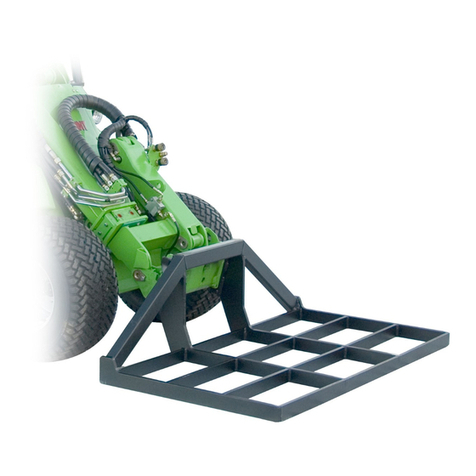
3(12)
1. Foreword
Avant Tecno Oy would like to thank you for your purchase of this AVANT attachment. It has been designed
and manufactured on the basis of years of product development and experience. By familiarising yourself
with this manual and following the instructions, you ascertain your safety and ensure the reliable operation
and long service life of the equipment. Read the instructions carefully before starting to use the equipment or
performing maintenance.
With these instructions, even an inexperienced user can use the pallet forks and loader safely. The manual
also includes important instructions for experienced AVANT operators. Ensure that all persons using the
equipment have received proper guidance and familiarised themselves with the manual and all safety
instructions before using the equipment. Keep this manual at hand throughout the service life of the
equipment. If the manual is lost, you can request a new one from the retailer or manufacturer. If you sell or
transfer the equipment, be sure to hand over this manual to the new owner.
2. Designed purpose of use
This AVANT pallet fork is an attachment designed and manufactured to be suitable for use with AVANT
multi purpose loaders. The pallet forks are mainly intended for handling standard sized pallets. With the fork
side shift mechanism, different pallet sixes can be transported easily. A load backrest extension is also
available, and it can be folded if extra overhead clearance is required. If lifting and load handling tasks are
frequent, equipping the loader with the boom self levelling and the electric joystick will make repeated lifting
tasks easier.
Pallet fork is an useful attachment all year round for example on construction sites, farms, and especially at
outdoor material handling jobs, where conventional fork-lift trucks are impracticable. When operating with
the pallet forks, the performance and stability limits of the loader must be observed, expecially when working
on inclined terrains. The pallet forks must not be used for lifting persons and it is prohibited to use the pallet
forks to lift any kind of access platform.
When lifting other material than pallets, the Log Grab attachment (A34822 or A33503), that can be fitted to
the pallet fork, is recommended. The log grab accessory makes it easy to handle single logs, smaller timber
bundles, fence poles, or similar material. The log grab is also suited for easy handling of tree branches and
bunches of twigs and also for moving large rocks. The handling of pallets is possible even if the log grab is
attached on the pallet forks, but the grapple limits the maximum height of the pallet.
The attachments have been designed to require as little maintenance as possible. Regular maintenance
tasks can be performed by the operator. Read the maintenance and servicing instructions in this manual.
Please contact your AVANT retailer if you have additional questions about the operation or maintenance of
the equipment or if you require spare parts or maintenance services.
3. Safety instructions for the pallet forks
Please bear in mind that safety is the result of several factors. The loader-attachment combination is highly
powerful, and improper or careless use may cause serious personal injury or property damage. Due to this,
you should carefully familiarise yourself with the manuals of both the loader and the attachment before
starting operation. Do not use the attachment if you have not familiarised yourself with its operation and the
related hazards.
The purpose of these instructions is to help you to:
•use the equipment in a safe and efficient manner
•monitor and prevent any hazardous situations
•keep the equipment intact and ensure a long service life




























